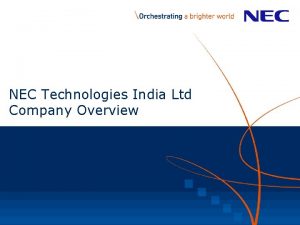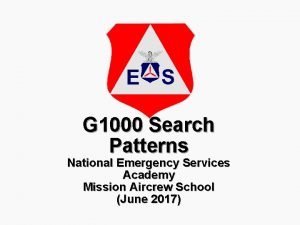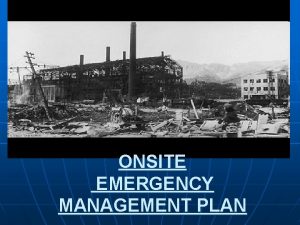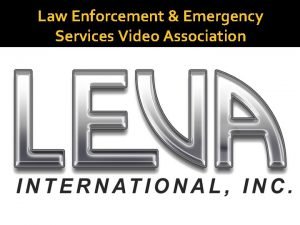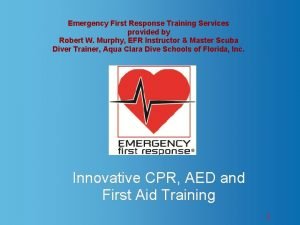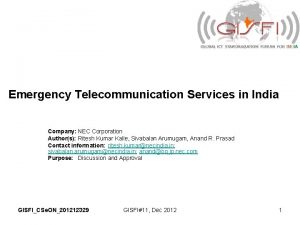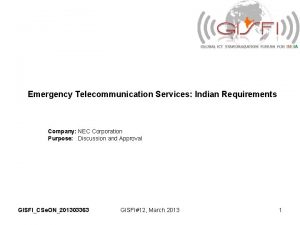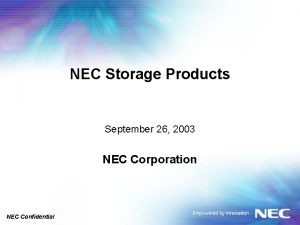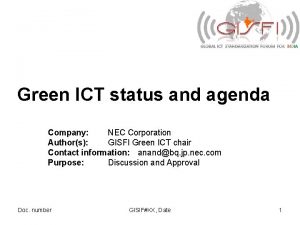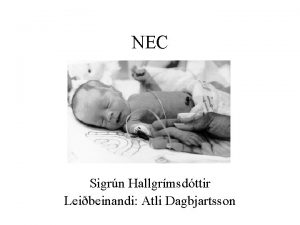Emergency Telecommunication Services in India Company NEC Corporation









- Slides: 9

Emergency Telecommunication Services in India Company: NEC Corporation Author(s): Ritesh Kumar Kalle, Sivabalan Arumugam, Anand R. Prasad Contact information: ritesh. kumar@necindia. in; sivabalan. arumugam@necindia. in; anand@bq. jp. nec. com Purpose: Discussion and Approval GISFI_CSe. ON_201212329 GISFI#11, Dec 2012 1

Outline • • • ETS in India : Regulatory requirements Way ahead Current Initiatives Key stakeholders ETS standardisation at Global SDOs GISFI strategy

ETS in India : Regulatory requirements • National Numbering Plan, 2003 from Govt. of India: – – • Use ‘ 100’, ‘ 101’ and ‘ 102’ for Police, Fire and Ambulance services ‘ 107 X’ for emergency information 1056 Emergency Medical Services (Toll free in local area) 108 Emergency Disaster Management Services (Toll free in local area) Clause 29. 1 of UAS license to the service providers: – “The licensee shall provide independently or through mutually agreed commercial agreements with other service providers, all public utility services including TOLL FREE services such as police, fire, ambulance, railways/ road/Air accident enquiry, police control, disaster management etc. While providing emergency services such as police, fire, ambulance etc. it shall be delivered to the control room of concerned authority for the area from where call is originated”. • India’s National Telecom Policy 2012 – “To facilitate an institutional framework to establish nationwide Unified Emergency Response Mechanism by providing nationwide single access number for emergency services. ” – “To create appropriate regulatory framework for provision of reliable means of public communication by Telecom Service Providers during disasters. ” National number plan : http: //www. dot. gov. in/numbering_plan/nnp 2003. pdf UAS license: http: //www. auspi. in/policies/UASL. pdf NTP 2012: www. dot. gov. in/ntp/NTP-06. 2012 -final. pdf

ETS in India : Way ahead • TRAI holding consultations with stake holders. Major issues identified: – System architecture: Centralized response systems vulnerable to attack. – • • Network resiliency required. Caller identification & location information in real time: Need of centralized subscriber information, accurate location information without GPS Location identification in case of SMS or data calls Interconnectivity arrangement amongst service providers, IUC charges Handsets without SIMs or inactive SIMs Provision of language translation services Code for disable persons like deaf and dumb who can not use voice calls – – – Harmonizing various existing emergency call centre services : EMRI 108, State police control rooms Dial 100, Fire 101, Ambulance 102 etc Police requirements to be addressed: – – Call back to ETS call originating phone (wired, mobile, IP phone) Officer to Officer priority calling facility Creation of standards as in USA [National Emergency Number Association, NENA] Designation of Public Service Access Points (PSAPs) for ETS routing TRAI Workshop on ETS: http: //www. trai. gov. in/Write. Read. Data/Events/Presentation/PPT/201211050508136092490 Shri%20 Sudhir%20 Gupta%20%20 Pr. %20 Advisor%20(NSL), %20 TRAI. pdf NENA Standards: http: //www. nena. org/? page=Standards

Current Initiatives • Crime and Criminal Tracking Network & Systems (CCTNS) Project within the outlay of Rs. 2000 crore in the 11 th Five Year Plan linking 14000 Police Stations in India http: //ncrb. nic. in/cctns. htm [WIPRO is the system integrator] • Bureau of Police Research & Development (BPRD) has taken up pilot studies for Integrated Emergency Calling System (IECS), DIAL 100. To be eventually merged with CCTNS, Centralized listed with connectivity to all cellular and wired systems nationwide http: //geospatialtoday. com/gst/index. php? option=com_content&view=article&id=2763%3 Aindia-tosoon-have-a-centralised-emergency-network-dial-100 -in-distress-&catid=1%3 Alatest-news&Itemid=81 • USTDA supported Feasibility Study for Ministry of Home Affairs in Hyderabad http: //www. ustda. gov/news/pressreleases/2011/South. Asia/India. Emergency. Communications_03 3111. asp [Optimal Solutions and Technologies, Inc. (OST), involved in carrying out the study] • TRAI workshop on implementation of Emergency Communication System (ECS) in India, Oct 31 2012 http: //www. trai. gov. in/Event_Sessions. aspx? EVENT_ID=116&Event. Type=1&qid=0 Participation by Police Dept (Dial 100 project) , EMRI (108 for Emergency), OST, Inc. (Consultant to IECS feasibility study, MHA), Representatives of Co. AI, TTSL, Reliance Communciation • TRAI consultation paper on priority routing of calls during disasters http: //www. trai. gov. in/Content/Consultation. Description. aspx? CONSULT_ID=623&qid=0 • POLNET project, Directorate of Coordination, Police Wireless, MHA, 1500 VSAT terminal based captive network for police communication http: //www. dcpw. nic. in/ • National Disaster Management Guidelines- Report, NDMA, National Disaster Management Information and Communication System (NDMICS), February 2012, http: //nidm. gov. in/PDF/guidelines/NDMICS. pdf

Key stakeholders • Govt. of India and State Governments – Ministry of Home Affairs (MHA) – Police Departments – National Disaster Management Authority (NDMA) • TRAI – Regulatory requirements for Emergency Communication • Dept. of Telecom – Numbering Plan • BSNL – Existing Emergency Toll Free numbers (100, 101, 102 etc) • COAI and member operators – Interconnectivity between operators, Common Emergency Service Access Point (Earlier all calls terminated in PSTN network run by BSNL) • Existing emergency service providers – GVK EMRI , Mahindra Satyam as technology partner – Police Control Room, Dial 100 and State wide area networks by state government • Bureau of Indian Standards – LITDC(Electronics & IT Division Council) is responsible formulation of Indian Standards in Electronics & Information Technology field

ETS standardisation at Global SDOs • ETSI: – ETSI is currently working for replying to the following EC mandates which are linked to Public Safety: • • • Mandate M/284 on “Harmonized standards for the R&TTE Directive”. private/professional land mobile radio systems and equipment. Mandate M/493 on “Support of the Location Enhanced Emergency Call Service” Standardize the determination and transport of caller location information for Vo. IP including a single functional model, the necessary interfaces and protocols. ETSI Committees involved : E 2 NA (as leader), EMTEL, MSG, BRAN and CABLE. ETSI Standard (ES 203 178) on functional architecture has been created. Mandate M/496: to develop standardization regarding space industry. It includes a dossier on disaster management (dossier 9). The mandate is of interest of ETSI TC SES. Also CEN/CENELEC TC 5(Space) are to work, chaired by the ECSS. – ETSI TC ERM and ETSI TC TETRA: • • • – ERM TG 26 : Maritime distress calls in VHF for Digital Selective Calling (DSC) – GSM-R standard in ETSI EN 301 515 and Change Requests specific to GSM-R are listed in ETSI TS 102 281. 3 GPP: – – – • Technical report (ETSI TR 102 628) on additional spectrum requirements for future Public Safety and Security (PSS) wireless communication systems in the UHF frequency range. ETSI TETRA Standard ETSI TS 100 392 2, TR 100 392 -17 -4 3 GPP standard on Public Warning System (3 GPP TS 22. 268) Regional variants: Earthquake and Tsunami Warning System (ETWS), Commercial Mobile Alert System (CMAS) , EUAlert (European Public Warning System )and Korean Public Alert System (KPAS) Work item on PWS security was approved in June 2012 for 3 GPP Release 12 3 GPP TS 23. 041 Technical Realization of Cell Broadcast Service 3 GPP TS 27. 005 Use of DTE – DCE Interface for SMS and CBS IMS based emergency calling services ITU: – ITU-T: • • Recommendation for CAP, an international XML-based data format for exchanging public warnings and emergencies Focus Group on Disaster Relief Systems, Network Resilience and recovery (FG-DR&NRR) – ITU-R: • • Recommendation M. 493, M. 541 for Digital Selective Calling (DSC) in Maritime emergency use ISO: – ISO 22322 Societal security – emergency management – public warning

ETS standardisation at Global SDOs • United States of America : – TIA and ATIS: • • • J-STD-110, Joint ATIS/TIA Native SMS TO 9 -1 -1 Requirements and Architecture Specification. J-STD-100. Joint ATIS/TIA CMAS Mobile Device Behavior Specification, J-STD-101. Joint ATIS/TIA CMAS Federal Alert Gateway to CMSP Gateway Interface Specification J-STD-102. Certification and Testing of the CMAS C-Interface J-STD-103. Joint ATIS/TIA Canadian Commercial Mobile Alerts Service. (CMAS)) – NENA: • • Accessibility CPE & Next Gen Integration Data Structures - Standards MLTS & PBX Standards Network Standards NG 9 -1 -1 & Vo. IP Standards Wireless 9 -1 -1 Integration Standards Korea: – TTAK. KO-07. 0046 Interface Standard for Terrestrial Digital Multimedia Broadcasting (T-DMB)Automatic Emergency Alert Service – TTAK. KO-07. 0054 Standard for Digital CATV Emergency Alert System Interface – TTAS. KO-07. 0055 Receiver Test Procedure for T-DMB Automatic Emergency Alert Service – TTAK. KO-07. 0078 Interface Standard for Satellite Digital Multimedia Broadcasting(S-DMB) Automatic Emergency Alert Service – TTAK. KO-07. 0080 Terrestrial Digital Multimedia Broadcasting (DMB) Emergency-Alert and Local Broadcast System for In-Tunnel and In-Door Services – TTAK. KO-07. 0085 Standard for Digital Satellite Broadcasting Emergency Alert System Interface • Japan: – ARIB: Cooperative ITS, as ARIB STD-T 109 Ver 1. 0; “ 700 MHz band Intelligent Transport Systems” – Earthquake and Tsunami Warning System (ETWS),

ETS in India : GISFI Strategy • GISFI Role: – Harmonization of International standards as applicable to India – Create specifications that become Indian standard • ETS standardisation in India : Potential areas – System architecture and ETS service framework – Spectrum requirements for ETS services – Caller identification & location information : To meet LBS requirements of Do. T – Location identification in case of SMS and Vo. IP call – PSAP architecture and interfaces – Support for Indian language translation services – Non voice calls for ETS for differently abled person – Cell broadcast based public warning system, – Satellite based ETS service – Security requirements of ETS services for India – Data management and interchange formats for ETS Services – Qo. S requirements for ETS services
 Nec corporation india private limited
Nec corporation india private limited Nec technologies noida address
Nec technologies noida address Export credit guarantee corporation of india limited
Export credit guarantee corporation of india limited Auxiliary services corporation of suny cortland
Auxiliary services corporation of suny cortland Metropolitan fire and emergency services board
Metropolitan fire and emergency services board National emergency services academy
National emergency services academy Onsite emergency plan
Onsite emergency plan Law enforcement and emergency services video association
Law enforcement and emergency services video association The importance of training
The importance of training European settlements in india 1498-1739
European settlements in india 1498-1739
